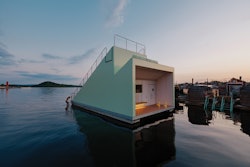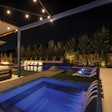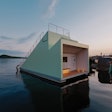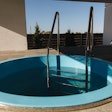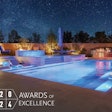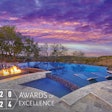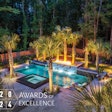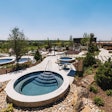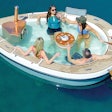Beth Hamil is vice president, corporate compliance, for Del Ozone in San Luis Obispo, Calif. Back in 1978, she was a 25-year-old Midwesterner beginning a career at a redwood barrel manufacturer on California’s Central Coast.
Tell us how you got involved in hot tubs.
I started in the hot tub business in 1978, the same year I had my second child. I was working for a company called California Cooperage, which was one of the first hot tub manufacturers. There were a couple of others, like Gordon & Grant in the Pacific Northwest that made redwood tanks, but there weren’t many.
When I joined the company they had already started what they called American Tank and Mill. It was in the same building as California Cooperage. They brought in raw redwood — it wasn’t trees, but it was damn near trees. So we started from nothing, put it through whatever equipment. Don’t even ask what we used. We put it through a planer, a joiner, put a concave on it, and added a tongue and groove. We had a patent for drilling a hole down the middle of the stave for air induction, which makes the jets frothy.
I got involved through a family member. They had a distributorship for California Coop in a town called Zion, Illinois. I went to work for them, and then I had my own little dealership for a year or so, then moved to California and started to work for the factory.
What was the level of awareness of hot tubs back then?
The original fellah at California Cooperage was Cliff Branch. You’d be hard pressed to find him nowadays. He was in San Luis Obispo and he was a marketing genius, in my opinion. He started it out as a mail-order company. The hot tubs came in kits, so you could just call and order them. They obviously weren’t on the Internet. But people called and got the tubs and built them in their backyards.
We ran full-page ads in places like Time. I remember in the ad there was a sales guy who was sitting there in a robe with all these models around him and it said, “Hot tubs make warm friends.” That was our little motto.
So it was a redwood barrel. They weren’t wine barrels, they were water tanks that they built for the tops of buildings. You can still go to big cities and see the redwood tanks on the tops of buildings.
I mean, people back then knew what a Jacuzzi was. I remember knowing about Jacuzzi whirlpool baths. And then, we just leveraged off of that somehow. I can’t tell you who really invented the idea or how it got started, though.
You mentioned you had a process for drilling into the staves.
A company called Waterway Plastics took our patented design of the hot tub jet and built them. Drilling into those staves was a difficult thing to do, so for every five that worked out we’d probably have two that didn’t. It was hard to drill to the center of the stave because you had to drill down 2 ½ feet or more. But all the tubs back then had four whole jets! Woo hoo! They had the jets, a suction fitting, then we’d put on a Hayward pump and a Lochinvar heater. Eventually we went to a Raypak heater. We also had an air blower made by a company that’s long gone now. Then, we had a circle of PVC pipe that ran around the bottom with a bunch of holes in it. We hooked the air blower up to that, and that’s how you got some more bubbles in the tub.
Eventually we added a skimmer because of the IAPMO rules to prevent entrapment.
When did the retail network start?
The little place I worked for in Illinois was the first distributor, then we got some dealers going. We went after swimming pool builders, stores that sold chemicals for pools. We targeted the pool industry because everything with hot tubs basically started out as taking pool stuff and miniaturizing it.
We got involved in spa manufacturing, in addition to the tubs, in probably ’81 or ’82.
Back then did you feel like you were part of a new industry?
I think we were just doing this thing. It didn’t feel like an industry. I think back in those days John Watkins had already developed his spa. It looked like a dog dish, which is what everybody called it, and Jacuzzi was making their bathtubs, then they got into spas. But we were hot tub people and we were into the whole California lifestyle, a hot tub in your backyard, maybe with some snow. I remember we put a hot tub in the backyard for my sister and brother-in-law and Life came out and did an article about them and this new hot tub craze. That was a big deal!
What kind of people were involved in hot tubs back then? Were they more laid back?
I would say they were more laid back! There are things I could tell you that you couldn’t possibly print, OK? It was crazy. We made a lot of money, and we had a lot of fun. [Crazy off-the-record story redacted].
We’re in San Luis Obispo, and there’s a university here, so we had degreed engineers, we had degreed accountants, degreed marketing people, because everybody that goes to school here wants to stay here. So we had a great gene pool to pull from. I think the group was very smart. We bought well, we worked with big vendors like Hayward and Raypak, Waterway Plastics. So we did everything right: good engineering, good packaging, we did an enormous amount of advertising in the trades and places like Time — that was not a cheap ad. Then, once we got the dealers started, it required far less retail advertising on our part.
I think the reason we were successful is that we really put our hearts into it. We had great manuals, we had great literature, a good warrantee, a great product, and we just grew and grew and grew. Eventually we sold to Coleman. They just kind of did away with our barrel business and sold the plastic spas we were making.
We also used to take redwood barrels and turn them on their sides and make them into saunas. When Coleman bought us they got rid of that, too, and moved everything to Arizona, and we all just dispersed.
It sounds like you guys had a lot of fun, but the business practices were not what one might expect from you.
We were very much on the ball. I’m still in manufacturing and I’m still in the industry, and I can tell you unequivocally we were definitely on the ball. But Cliff Branch didn’t want people thinking he was doing as well as he was. He would write letters using incorrect English just so it would look like we were a bunch of college kids trying to make our way through school. Yet, it was a very savvy business. We had good books, good engineering documentation, and a gorgeous building. Oh my God. It was incredible. People loved what we were doing, and we did things the right way.
There were a lot of people in the business back then that weren’t great business people, but we weren’t one of them. It’s really great reminiscing about this, and I could keep you on the phone for hours and hours.
Are there still some old tubs out there?
Ugh. I have no idea, to tell the truth. The last one I had I sold to somebody who sold to somebody, and I lost track of it years ago. Once the tubs went out the door, we really lost track of them, especially once the mail order business went away and they were sold mostly through dealers.
Comments or thoughts on this article? Please e-mail [email protected].























